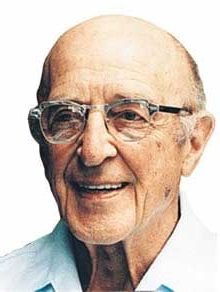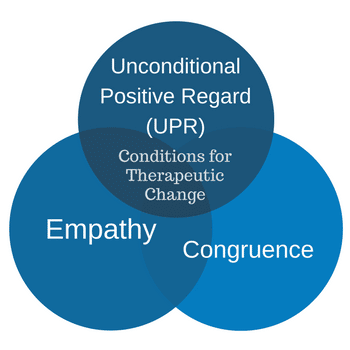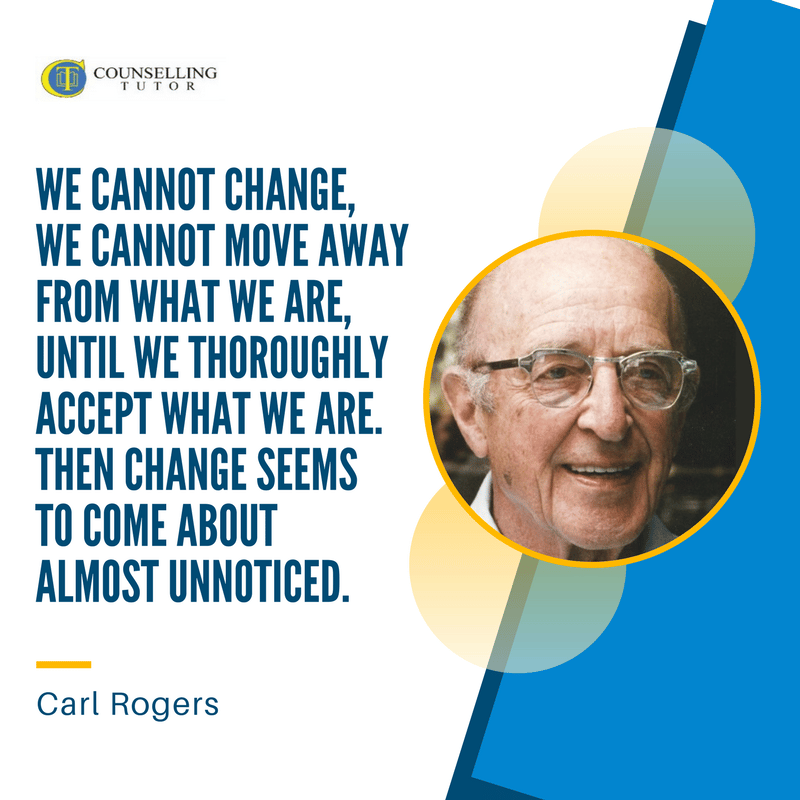Carl Rogers - Person Centred Therapy
Carl Rogers (1902-1987) is best known for devising Person-centred theory (also known as client centred theory), which is influenced by humanistic theory. He paved the way for client led therapies.
Carl Rogers produced many valuable theories, including:
- ‘The Necessary and Sufficient Conditions of Therapeutic Personality Change’ which includes the more widely known ‘Core Conditions’ (empathy, congruence, unconditional positive regard) and three ‘hidden conditions’

- The Seven Stages of Process, the stages a client goes through during therapy. Providing a common language with which counsellors can track client progress.
- The 19 propositions (Roger’s theory of personality) which is based upon the ideas of consciousness is experienced from the first point of view, behaviour is a product of self-belief, and a safe emotional environment is necessary for psychological change to take place.
He also developed a rich vocabulary for understanding how human beings perceive the world. The term ‘'locus of evaluation’ has become known as the way we make sense of the world around us.
An internal locus of evaluation sees us trusting our organismic self. Conversely, if we receive conditions of worth (conditional love) from others when we were young, we develop introjected values. As a result, we live our lives from an external locus of evaluation – in other words, being able to be happy only when we have the approval of others.
The Humanistic Approach / Theory
It is humanistic psychology that underlies today’s person-centred approach, originally known as ‘client-centred therapy’. The humanistic approach to counselling is sometimes referred to as the ‘third force’ of psychology, a term coined by American psychologist Abraham Maslow in 1968 – the first force being psychoanalysis and the second behaviourism.
Carl Rogers adopted humanistic theory into his person-centred therapeutic model. Tudor and Merry (2006, p.68) note that ‘it was significant for the later development of his ideas that Rogers’ first graduate training was at the liberal Union Theological Seminary in New York and that he was attracted to and encouraged in unorthodox thinking’.
Rogers first explained his developing theory in a Minnesota lecture entitled ‘Newer concepts in psychotherapy’. Thorne and Sanders (2012, p. 12) report that ‘he subsequently came to consider the date of this event as the birthday of client-centred therapy’.
There – to an outraged audience – Rogers criticised the traditional approach to therapy, particularly the practice of directive advice-giving (which was part of both Freudian psychoanalytic and Skinnerian behaviourist approaches), and advocated ‘helping individuals to grow and develop’ (believing that everyone has the ability to trust in themselves enough to make their own decisions), an ‘emphasis on feelings and emotions rather than on cognitive aspects of a situation’, ‘a focus on the present rather than the past’ and ‘the crucial experience of the therapeutic relationship itself as a major element in the growth of the client’ (ibid., p. 13): all key features of the humanistic approach.
The humanistic approach has three main theoretical pillars:
- the six necessary and sufficient conditions for therapeutic personality change (which include the more widely known ‘core conditions’)
- the seven stages of process (Rogers’ model of individual human development)
- the 19 propositions (his theory of personality).
Carl Rogers' Theory
The Core Conditions
Alfred Adler’s work on change was a particular inspiration for Rogers’ 1957 article, ‘The Necessary and Sufficient Conditions of Therapeutic Personality Change’, which describes the conditions needed for humans to grow/thrive.

In addition to Rogers’ belief that all humans are born intrinsically good, he held that they are self-determining (i.e., the best placed to make decisions for themselves and to sort out their difficulties), so long as they experience the right conditions from others. The three core conditions for this are empathy (i.e., understanding), congruence (genuineness) and unconditional positive regard (UPR: non-judgement).
Although these are the best known, Rogers also proposed three further conditions required for effective therapy: therapist–client psychological contact (i.e., a sound relationship between the two parties); client incongruence (a mismatch between the client's experience and awareness, meaning that the client feels vulnerable or anxious); and client perception of the therapist’s empathy and UPR.
Rogers (1957, pp. 95–96) asserted: ‘No other conditions are necessary. If these six conditions exist and continue over a period of time, this is sufficient. The process of constructive personality change will follow.’
The term ‘core conditions’ was not used by Rogers but was coined later – in the 1970s and 1980s – by the British person-centred movement. Other terms used to refer to the core conditions are the ‘facilitative conditions’ or ‘therapist’s conditions’. The remaining three conditions are sometimes referred to as the ‘hidden conditions’, ‘client’s conditions’ or ‘lost conditions’.
The Seven Stages of Process
Rogers’ model of the seven stages of process within the client describes how a person experiences a developing sense of sense and how open they are to self-change.
Feltham and Dryden (1993, p. 181) refer to the seven stages of process as one model of stages of change: ‘the marked phases which clients (or people attempting self-change) pass through … Rogers’ (1961) 'stages of process' runs from 1 ('remoteness from experiencing') to 7 ('experiencing effective choices of new ways of being).’
In his book On Becoming a Person, Rogers (1961, p. 131) writes:
Individuals move, I began to see, not from a fixity or homeostasis through change to a new fixity, though such a process is indeed possible. But much the more significant continuum is from fixity to changingness, from rigid structure to flow, from stasis to process.
This theory provides a valuable common language with which counsellors can track client progress and discuss this in both clinical supervision and case studies.
Rogers identified that the journey between stages is not linear, and that people move both ways. Tolan (2003, p. 112) describes this as follows: ‘It is rare to find someone who shows signs of being in only one “stage” at a time. At some points, a client might even seem to the counsellor to have “gone backwards”.’ By stage 6, however, progress tends to be more secure, and self-growth is then able to continue without the counsellor.
The seven stages of process describe an organic process and are not intended to be used as a framework to ‘push’ clients. Merry (2014, p. 59) writes: ‘There are no direct interventions that can be made or should be made in an attempt to move the client from one stage to the next to speed up the process.’
Free Handout Download
Key Events in the Life of Carl Rogers
The 19 Propositions
It was in 1951 that Rogers wrote Client-Centered Therapy, the first full version of his theory, which includes a chapter devoted to his theory of personality and behaviour (in the form of 19 propositions).
In developing this part of his theory, Rogers (1951, p. 482) drew on the work of other psychologists and on his own experience of counselling clients: ‘Taken as a whole, the series of propositions presents a theory of behavior which attempts to account for the phenomena previously known, and also for the facts regarding personality and behavior which have more recently been observed in therapy.’
The 19 propositions represent the following key ideas:
- Consciousness is experienced from the first-person point of view.
- Behaviour is a product of self-belief.
- A safe emotional environment is necessary for psychological change to take place.
The 19 propositions thus emphasise the key role in the person-centred approach of the phenomenological field – i.e., all that the organism experiences, consciously and otherwise; this is inevitably subjective and therefore not a precise reflection of any objective reality. Rogers writes (1951, p. 532):
This theory is basically phenomenological in character, and relies heavily upon the concept of the self as an explanatory construct. It pictures the end-point of personality development as being a asci congruence between the phenomenal field of experience and the conceptual structure of the self.
Merry (2014, p. 34) writes: ‘The nineteen propositions repay careful reading because together they provide us with an elegant theory of how and under what circumstances people change, and why certain qualities of relationship promote that change.’
Thus, the 19 propositions are of value to counsellors both in working with clients and in developing ourselves, since – in Kelly’s words (2017, p. 51) – ‘part of the counselling journey, specifically in PD [personal development] groups, is about encouraging those elements of our personality that are invisible to us – perhaps not-for-growth elements of ourselves – to come into our awareness, challenging us to look at them.’
Carl Rogers Biography
Carl Rogers - Early Years
Carl Ransom Rogers was born on 8 January 1902 in Oak Park, Illinois, a Chicago suburb. His parents – Walter A Rogers and Julia M Cushing – were both devout Christians attending a Pentecostal church.
Rogers became the fourth of six children, who were brought up in a strict religious and ethical environment. He was taught to read at home before he attended kindergarten, where he was deemed so advanced that he immediately joined the second-year students.
In 1914, the Rogers family bought a farm in the neighbouring suburb of Glen Ellyn. There, the young Rogers gained his appreciation of the scientific method, by observing moths and other living things.
Rogers was a prolific writer and also published many other books and papers during his life.
Click for a list of Carl Rogers Quotes.
Carl Rogers Study Career
In 1921, Rogers attended the University of Wisconsin to study agriculture but soon changed course to study history instead. A year later, he attended the World Student Christian conference in Beijing and spent six months in China.
In 1924, Rogers graduated from the University of Wisconsin with a Bachelor of Arts degree in history. He initially enrolled at the Theological Seminary in New York to become a church minister.

However, in 1926, he married Helen Elliot and decided against a career in religion, instead signing up to study psychology and teaching at the University of Columbia.
Early Professional Career
On graduating, he took a position at the Rochester Society for the Prevention of Cruelty to Children, later serving as Director. In 1931, he was awarded his PhD for research on the Rorschach ink-blot test.
It was during his tenure at Rochester that Rogers became strongly influenced by a social-worker colleague who had studied under the psychotherapist Otto Rank.
Rogers also came across the work of Jessie Taft, one of the key female voices in the development of person-centred therapy. Taft was already an accomplished author and had also translated Rank’s work from German to English for an American audience. It was the ideas of Rank and Taft that laid the ground for what Rogers would call ‘non-directive therapy’.
"Rogers realised the power of letting the client speak about their world, without ‘expert’ intervention."
Anecdote has it that there was one particular event at Rochester that altered the direction of Rogers’ thinking – and thus the world of psychotherapy forever. According to this, when Rogers was working with a child who had behavioural issues, he tried to convince the mother that the reason the child was behaving badly was because of her early rejection of the child.
The mother stormed out, only to return and ask whether Rogers took adults for counselling. When Rogers replied that he did, she proceeded to tell her own story.
Rogers realised the power of letting the client speak about their world, without ‘expert’ intervention. This encounter formed that basis of what he later described as ‘client-centred therapy’ or – in Abraham Maslow’s words – ‘the third force in psychology’.
Free Handout Download
Key Events in the Life of Carl Rogers
Acknowledgement of Carl Rogers' Contributions to Psychology
While Rogers’ ideas attracted criticism from the psychotherapeutic community, they also gained wide acceptance over time.
Rogers was honoured with many awards and accolades, including being elected a fellow of the American Academy of Arts & Sciences in 1961.
He was also nominated for a Nobel Peace Prize for his work in Northern Ireland and Russia, where he tried to bring differing factions together in the hope of finding common ground.
Sadly, the nomination for the Nobel Peace Prize arrived a few days after his death on 4 February 1987, caused by a fall at his home in La Jolla, California.
References
Feltham, C. and Dryden, W. (1993). Dictionary of Counselling. London: Whurr.
Kelly, K. (2017). Basic Counselling Skills: A Student Guide. Counsellor Tutor Ltd.
Merry, T. (2014). Learning and Being in Person-Centred Counselling. Ross-on-Wye: PCCS Books
Rogers, C. (1951). Client-Centered Therapy. London: Constable.
Rogers, C. (1957). The Necessary and Sufficient Conditions of Therapeutic Personality Change. Journal of Consulting Psychology, 21, 95–103.
Rogers, C. (1961). On Becoming a Person: A therapist’s view of psychotherapy. London: Constable.
Thorne, B. and Sanders, P. (2012). Carl Rogers. 3rd ed. London: Sage.
Tolan. J. (2003). Skills in Person-Centred Counselling & Psychotherapy. London: Sage.